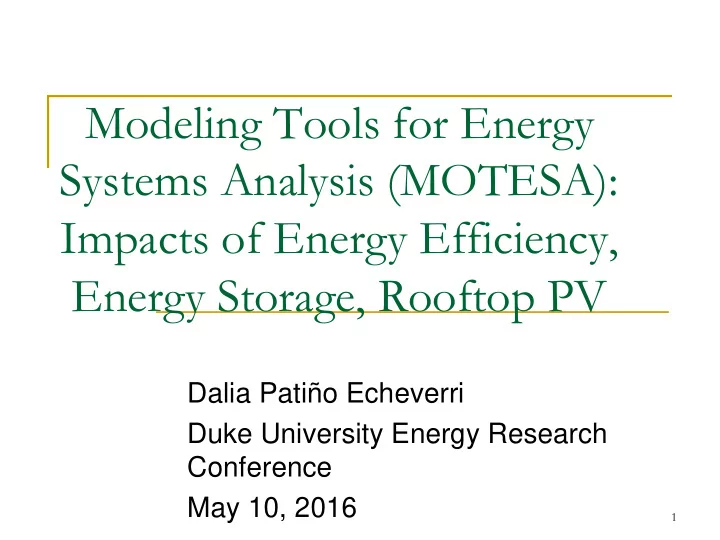

Modeling Tools for Energy Systems Analysis (MOTESA): Impacts of Energy Efficiency, Energy Storage, Rooftop PV Dalia Patiño Echeverri Duke University Energy Research Conference May 10, 2016 1
The goal of this presentation To present a method/model we have available to assess the effects of introducing different energy generation and non- generation resources in an electric power system In case this method can be used to explore a questions some of you may have and we can collaborate Previous presentation of this resource led to a collaboration with Angel Peterchev to assess the impacts of deploying the AC battery at the system level 2
MOTESA: Production Cost-Based model to simulate operations of a power system Two versions representative of MISO DEP/DEC Resolution: Plant level representation Day ahead commitment of unit and Real time dispatch – every 5-10 minutes during a full year 3
Main Goal of Power System Simulation Model To explore the effects of different low-carbon strategies on the performance of Power Systems: Economics Costs of generating electricity Electricity Prices in the day-ahead and real time Payments to generators Environmental Performance CO2 and other air emissions from power plant operation Accounting for the increased emissions from starting-up units and operating at minimum loading levels Reliability Instances of energy imbalance (when demand <> supply) Instances of reserves shortages (when available reserves are lower than target) 4
Big effort on Big effort characterizing the Motesa’s PCB model characterizing uncertainty on net costs and load emissions Real Time Day Ahead Market Generator Costs Market Energy Cost Real-Time Spinning Reserve Cost Startup Cost System Day Ahead No Load Cost Requirements System Reqs Actual Net Load Forecasted Net Load Generator Reserve Requirements Reserve Requirements Regulation Requirements Parameters 3 different Max Ramp Rates Min/Max Generation types: conv, Min Uptime Repeat Every stochastic, Min Downtime Flexiramp 5 Minutes Day Ahead Unit Real Time Economic Day Ahead Output/ Commitment Dispatch Real Time Input Int Length: 1 hr Int Length: 5 Mins Commitment (on/off) # Intervals: 24 # Intervals: 1 Schedule LP or MILP Key models: Minimize Real-Time Output Intermediate Outputs Models costs (or maximize Generator Dispatch Inputs welfare) subject to Final Outputs Market Clearing Price Spin Reserve Dispatch and Price constraints
What are the impacts on costs, reliability and air emissions of Roof-top PV Investments in end-use energy efficiency Deployment of modular “AC Battery” for central dispatch Seed research funding with A What are the benefits Peterchev from this Battery? 6
impacts on costs, reliability and air emissions AC batteries Annual Round Trip Monetized Monetized Total System Reduction in Efficiency Reliability Benefits Emission Benefits Benefits Total System % $ $ $ $ 80 2,970,893 Deployment of modular 90 2,790,746 95 2,959,986 80 200,000 “AC Battery” for central 90 300,000 95 300,000 80 -293,051 dispatch 90 -363,868 95 -244,262 80 2,877,842 90 2,726,878 95 3,015,724 7
Thank you! Dalia.patino@duke.edu 8
Recommend
More recommend